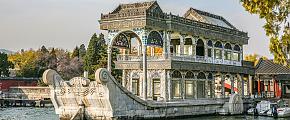Chinese Architectures - Bridges
Chinese bridges from ancient times, highly varied in material and form, are an important legacy with national characteristics, occupying an important position in the world history of bridge building. China, a country with such a long history, has inherited from her past bridges without number: there are, it is said, four million of them if one counts the stone arch bridges alone. In the southern regions of rivers and lakes, the landscape is dotted with bridges of various sizes and descriptions, which make it all the more picturesque.
1. The Stone Arch Bridge
The stone arch bridge is the most common type of bridge one sees in China. According to historical records, the first arch bridge, named Lurenqiao (Wayfarers' Bridge) was built in A.D. 282 near the ancient Luoyang Palace. That was more than 1,700 years ago. Then, in a Luoyang tomb dating back to the early Zhou Dynasty, archaeologists found the gate to the burial chamber to be an arch structure, showing that the stone arch existed in China since about 250 B.C. at the latest.
Anji Bridge is the most famous stone arch bridge in China. It spans the Jiaohe River in Zhaoxian County, Hebei Province, and is better known as Zhaozhou Bridge after the ancient name of the county. Built during the years 591-599 A.D. by the mason Li Chun, it is still being used as a bridge, so it is one of the bridges with the longest service life in the world. It is 9 meters wide and stretches all 50.82 meters on a single arch spanning 37.4 meters of the river. On each of the "shoulders" of the main arch, there are two spandrel or minor aches. They not only improve the general look of the bridge but help to reduce its weight and thus lighten the load on its foundations. In times of floodwater, the minor arches join the main one to facilitate the passage of the current, weakening its impact on the body of the bridge. A masterpiece of bridge construction, this old stone structure has been taken in subsequent ages as the model for stone arch bridges.
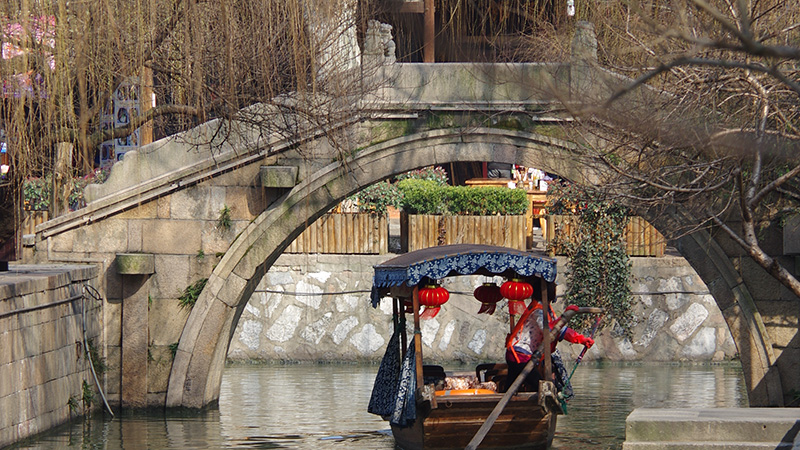 Bridge of Nanxun Ancient Town, Hangzhou
Bridge of Nanxun Ancient Town, Hangzhou
On wide rivers and lakes, multiple arch bridges were erected of stone. One of them is Lugouqiao (better known to Westerners as Marco Polo Bridge). Built in 1189-1192 in the southern vicinity of Beijing, it is 265 meters long and lies on 11 arches, which range in their span from 16 to 20 meters. The tops of the 280 stone balusters flanking the bridge are carved in the form of squatting lions. It is, therefore also called popularly as Shiziqiao (Lions Bridge), making it one of the scenic spots around Beijing.
The bridge with the largest number of stone arches is Baodaiqiao (Treasure Belt Bridge) on the Grand Canal in Suzhou. Winding 317 meters long, it is formed of 53 arches, three of which are higher than the others to allow the passage of boats sailing on the main channel. The floor of the bridge is level and smooth, making it easier for the boat trackers of the old days to trudge on. It is said that the bridge was built with money realized from a precious belt donated by Wang Zhongshu, Governor of Suzhou in the Tang Dynasty (618-907 A.D.), hence its name. It has become one of the local sightseeing attractions.
The stone arch bridge is strong and sturdy but capable of being built in a great variety of shapes. It has long been used as a landscaping structure in China. A splendid example is Yudaigiao (Jade Belt Bridge) in Beijing's Summer Palace. A stone bridge of a single span, it has a high arched back, rather like the hump of a camel. Flanked by finely-carved white marble balustrades, it is a picturesque decoration of the lake.
But the typical example of a landscape bridge is the Seventeen-arch Bridge in the same palace. Built-in 1750, the 150-meter-long bridge has often been compared to a rainbow spanning the lake between the eastern shore and Nanhu Island. Adorning the stone balustrades on the sides are 554 lively lions exquisitely carved out of marble.
Technical improvements have been made since the founding of New China. In 1966, a single-span stone bridge with minor arches was built at Yixiantian on the Chengdu-Kunming Railways. It is the largest of its kind, being 63.2 meters long and 26 meters high, with the main arch spanning 54 meters. Again, in 1971, a stone bridge was constructed at Jiuxigou in Fengdu County, Sichuan Province. Straddling 116 meters on a single span, it is the largest single-arch stone bridge in China up to date.
Stone arch bridges are highly resistant to weathering and can be very beautiful and dignified. Their material is often available locally. For these reasons, they still have a great future even though other bridges are being built with more modern techniques.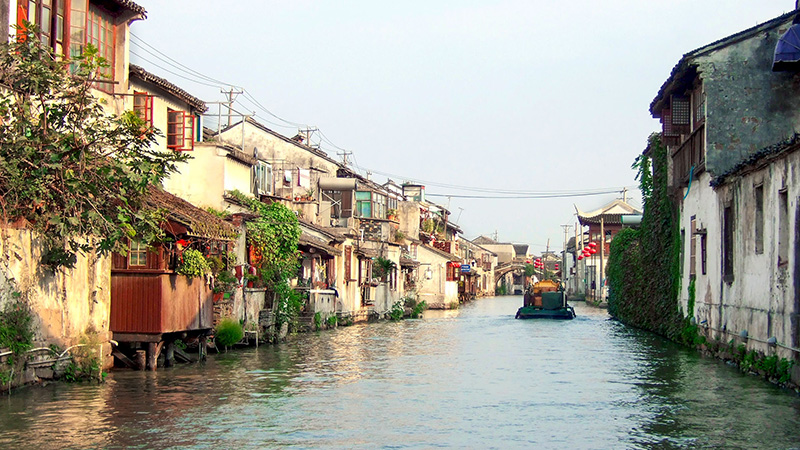
2. The Zigzag Bridge
A landscaping structure, the zigzag bridge, is found in some gardens or suburban scenic spots. It is intended to give an interesting feature to the scene on lakes and ponds and enlarge the scope of the sightseers' stroll over the water's surface.
Such a bridge may have three, five, or more zigzags. Jiuqu Qiao (the Nine-bend Bridge) in Yuyuan Garden of Shanghai's old town is the typical one. Going over a lake thirty meters across, the bridge winds more than a hundred meters because of its nine twists. Flanked by balustrades with square posts, it also has by its side a mid-lake pavilion in which visitors may have a cup of tea upstairs and enjoy the view all around. Another well-known zigzag bridge lies at Gulangyu, a beautiful island just off the Fujian city of Xiamen (Amoy). Zigzagging along the islet's southern shore, the bridge lies nestled against a nice garden.
Standing on it at intervals are graceful pavilions known under such names as "Watching Anglers", "A Thousand Waves" and "Moon in Water." Ramblers on the bridge draw pleasure from the feeling as if they were walking on the sea, especially when the tide is in.
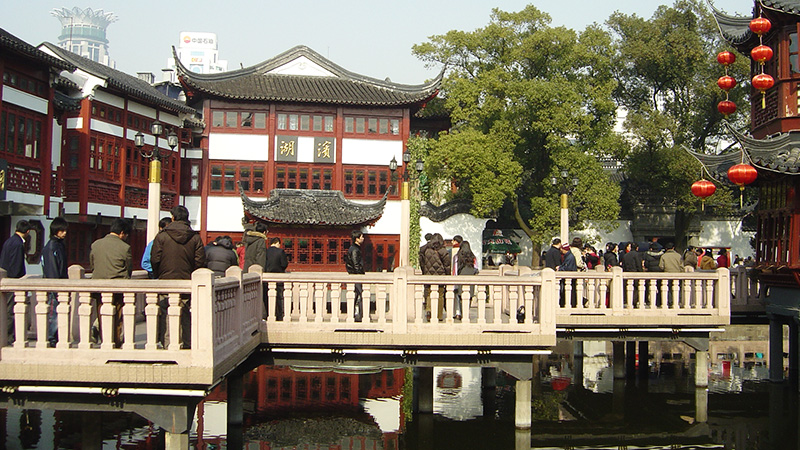 Jiuqu Qiao in Yu Garden, Shanghai
Jiuqu Qiao in Yu Garden, Shanghai
3. The Cross Bridge
This is a very rare bridge in China; in fact, probably only one of its type still exists in the country. Named Yuzhaofeiliang (Flying Bridge over Fish Pond), it is situated in front of the Hall of the Goddess in the Jinci Temple of Shanxi Province. It is a stone bridge with "wings" so that it looks like a cross. The main bridge floor is 18 by 6 meters, while each wing is 6 meters long and 4 meters wide. Erected over a pond, in which fish play about, it also looks like a huge bird about to take off. Sightseers may get on it from any direction and cross the lake any way they want. According to recorded history, such cross bridges began to be built as early as the Northern Wei Dynasty (A.D.386-534). The existing one just described is thought to have been built during the Northern Song (960-1127) at the same time as the Hall of the Goddess. Nearly a thousand years old, it is generally regarded as a treasure among ancient Chinese bridges.
4. The Pavilion Bridge
A component part of the art or landscape gardening, the pavilion bridge is often built over the surface of a quiet lake, forming a small scenic area and providing sightseers with a place for a rest, sheltered from the sun and rain.
The Five-Pavilion Bridge (Wufeng Qiao) in Yangzhou, Jiangsu Province, is a fine example of this style. Built-in 1757 and like a belt worn on the narrow waist of Shouxihu (Slender West Lake), it bears five pavilions on its 55-meter-long floor. The middle pavilion is higher than the other four, which are spaced two on each side in perfect symmetry. And the middle pavilion is a double-caved structure while the rest have only single eaves. All pavilions have their four corners upturned, with rows of tiles gathered up in the middle under a Baoding (roof crown-see a previous article). The pavilions, lined up with short covered corridors, have yellow glazed tiles on the roofs but green ones for the curving ridges, forming a splendid contrast of color.
Inside the pavilions, the ceilings are decorated with colorful sunk panels, and the beams and columns are carved with beautiful patterns. The body of the stone bridge is formed on 15 arches of varying sizes, all large enough to allow the passage of boats that ply the lake. In contrast to the exquisiteness of the pavilions, the supporting piers look sturdy and rugged. With its structural complexity. the bridge may claim to be a masterpiece of its kind.
Fengyuqiao (Wind-and-Rain Bridge), on the Linxi River in the Dong Autonomous County of Sanjiang in the Guangxi Zhuang Autonomous Region.
Another well-known pavilion bridge is Chengyang Bridge, also known as Fengyuqiao (Wind-and-Rain Bridge), on the Linxi River in the Dong Autonomous County of Sanjiang in the Guangxi Zhuang Autonomous Region. Built in 1916, the bridge is not so old. Its wood body, 70 meters long by 10 meters wide, rests on piers built completely of big stone blocks. Standing on it are five tile-roofed and pagoda-like pavilions connected by a long covered corridor. So the bridge may also be described as a covered bridge.
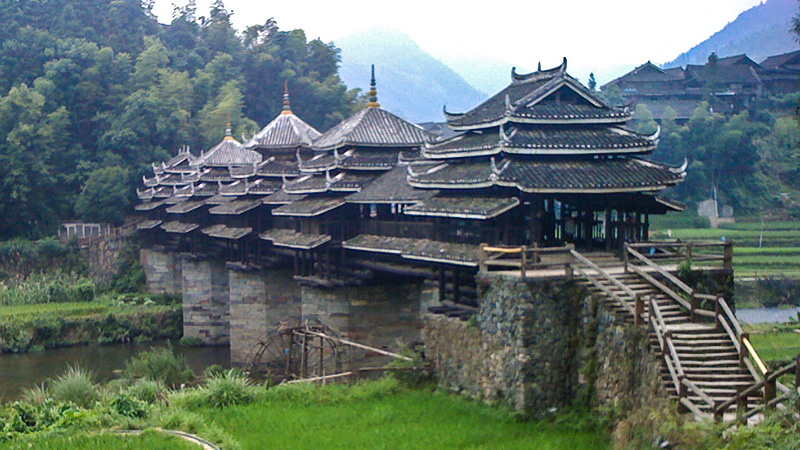 Chengyang Bridge in Guilin
Chengyang Bridge in Guilin
The five-storeyed pavilions have multiple eaves, which are upturned as if about to take wing. The wall panels in the pavilions and corridors are carved with popular Dong motifs, showing marked characteristics of this ethnic minority. All the well-structured woodwork, crisscrossed with thousands of laths, purlins, and rafters, were joined together by means of tenons and mortises without the use of a single nail, bearing testimony to the ingenuity of the Dong people.
There are in China a large number of bridges with pavilions and corridors; they can often be seen especially down in the south. The buildings of some bridges are so large that they could be used as meeting halls or trade markets on water.
Quick Question
What Our Clients Say
"Great Customized Service", "Trip of A Lifetime", "Exceed All Expectations"
SUBSCRIBE TO WIN A FREE TOUR
Subscribe to our newsletter for a chance to win a free 7-day India tour! And more insider travel news, exclusive offers, and inspiration will be sent straight to your inbox.




